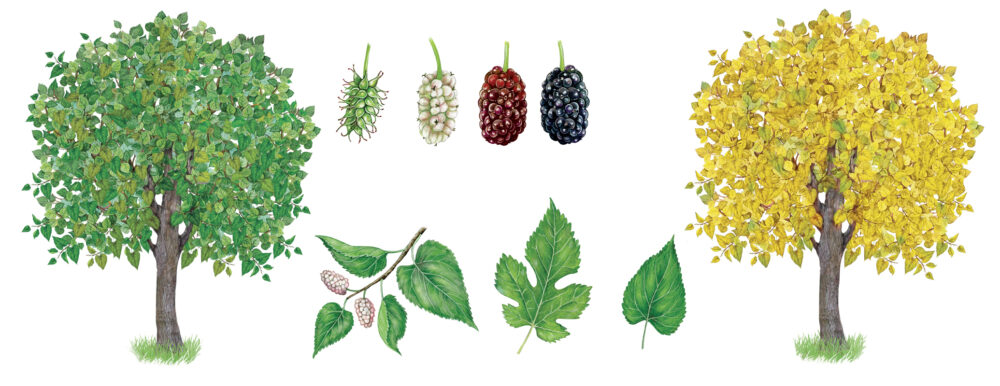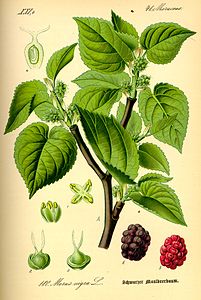The mulberry is a tree characterized by a high longevity and can reach a height of 10-15 meters. The trunk is erect with a bark of brownish and deeply reticulated grid colour, especially in the older individuals. The crown appears expanded and globose in shape.
The roots of the mulberry are of a typical orange yellow color and characterized by a high strength and elasticity.
The leaves appear deep green on the top and grayish on the bottom. They have a long peduncle and can have very different shapes and sizes depending on the variety. The plant takes on a bright yellow color in autumn.
The species is generally dioecious and the flowering goes from March to May. The male trees produce small yellow flowers grouped in small pedunculated spikes while the female ones develop greenish small flowers gathered in small flower heads.
The plant produces an infructescence that is improperly called 'blackberry'; this is in fact a set of more fruits and is called 'sorose'. The sorose has a generally oblong shape with a color that varies from black to white, depending on the species. The ripening of the fruits is scalar and can continue throughout the summer.
The mulberry is a rustic plant that is suitable for living in different pedoclimatic conditions. It grows on all types of soil and is able to survive even at temperatures considerably lower than 0.
The mulberry has always been a characteristic element of the Tuscan countryside; its leaves served as nourishment for the silkworm (Bombyx Mori), a moth whose breeding was very practiced by peasant families. Mulberry also provided fodder for domestic animals and its wood was used to produce tools. Unfortunately, many of the mulberry rows have been eliminated and often remain only isolated specimens in the rural landscape.
It is hypothesized that the cultivation of the mulberry tree began in 2700 B.C. in East Asia for the production of silk. In medieval times this reached exorbitant figures and was believed to be produced directly from the tree.
According to legend, the Emperor Byzantium promised a large reward to anyone who could bring the precious eggs from China and the enterprise succeeded to two monks who hid them in bamboo sticks. In fact, it was the Arabs, around the fifteenth century, who brought the eggs and the mulberry plant to Europe, thus starting the mulberry cultivation. The mulberry began to expand and frame the fields, the banks of the ditches and canals.
Around 1500 the plant became so important in Italy that it entered laws and decrees. At the end of the 19th century, thanks to industrialization, the mulberry spread enormously and Italy became the leading producer of silk in Europe.
Due to the introduction of synthetic fibers, cheaper and easier to obtain, and the loss of value of mulberry leaves, there has been a decline in the cultivation of the plant. The mulberries were largely eliminated then to expand the fields.
In our territory there are two species of mulberry that can be encountered: the Black Mulberry (Morus nigra) and the White Mulberry (Morus alba).




